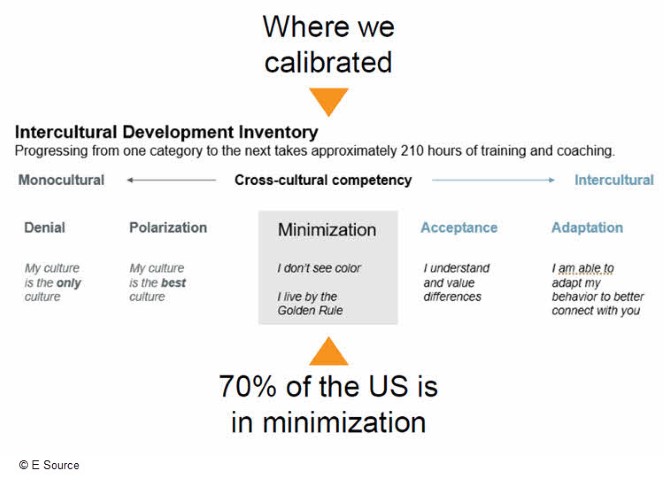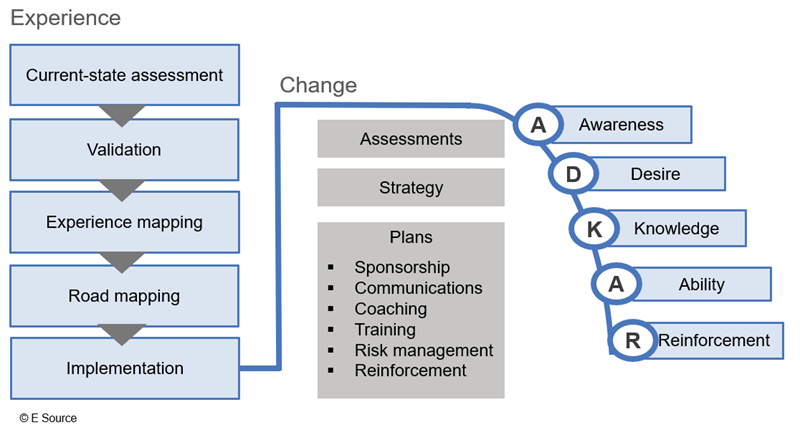Movies like Everything Everywhere All At Once and Spider-Man: Across the Spider-Verse helped bring the multiverse into the mainstream. According to the Live Science article What is multiverse theory? parallel experiences exist simultaneously in time and space—one being just as impactful on real-world results as the others. If that’s true, the multiverse could be the missing link in solving for effective change management in the present.
Whether it be PROSCI, human-centered design, Agile, etc., most business frameworks assume one set of rules applies to everyone. In other words, everyone is similar enough that one approach is sufficient. Meanwhile, 70% of change fails. In an attempt to simplify complexity, problem dimensions are distilled into time and task. Diversity, equity, and inclusion (DEI) feel sequestered in another space/time continuum.
But just like in a multiverse, managing change requires adapting how you see and solve the problem to deploy an interculturally competent solution. To help you in your journey, you can read this blog post as a thesis, mindset, and map to help elevate existing models with intercultural competency based on my 20-plus years of consulting work, experience, and learnings across the utility, healthcare, financial services, and other public sector industries. My hope is to provide you with four rules—or better yet, a multipronged compass—to help you navigate transformation no matter what universe you’re in.
Rule one: Your perspective isn’t universal
In the multiverse, you first must realize your view isn’t universal. Most of our fundamental business models were developed long ago by a not-so-diverse group, causing unconscious bias to be baked into the design. But experience is divided culturally. And culture is the lens through which individuals, teams, and organizations see the world (figure 1). It creates the fabric of our multiverse.
Figure 1: What experience can do
The opposite of assuming individual characteristics and factors define the experience lands us in universalism. Universalism sees everyone as essentially the same down deep. It assumes we all have the same values and that treating others as you’d like to be treated is the right path. What’s universal anchors back to a stereotypical mindset of scrunching the world down to your view. And that’s where we miss the multiverse.
In the multiverse, values aren’t universal. Experiences are interpreted through a cultural lens. For example, imagine educating an audience on an EV program. One audience member owns a home and just installed solar panels while another rents an apartment in an urban area and struggles to keep up with their utility bills. The chipper speaker asks the icebreaker question, How many of you own an EV? Someone who installed solar panels might already own or be in the decision-making process of buying an EV (so the icebreaker likely will have a positive result), but a renter might consider the icebreaker tone-deaf or elitist.
Your homework: Begin to surround yourself with others who don’t look, think, or act like you. Seek out their perspective on a shared experience or news event. Listen and ask questions to better understand what they value and what drives decisions in their world.
Rule two: Culture starts with self-realization
Your ability to see the multiverse is based on your ability to understand and factor other cultures into your decision-making. Understanding cultural differences begins with your ability to recognize similarities and differences.
In my blog post How building intercultural competency drives equitable decision-making, I dove into intercultural competency, which is our ability to recognize and navigate the multiverse of culture. I explained how it can be measured through an international benchmark called the Intercultural Development Inventory (IDI). What contributes to the illusion of universalism is that most of the US is in the stage called minimization, including E Source (figure 2). Minimization is seeing the world through your own values and thinking that everyone else sees things as you do.
Figure 2: E Source IDI results
Why does this matter? It matters because unless you’re able to detect your blind spots, there’s no way for you to see the actual root of the problem clearly. For example, a common misconnection of driving utility program participation is that it’s a matter of getting the message out. Rarely is there much reflection on the program design—if it fits the needs of the intended audience or addresses the real problem at hand.
Here’s another hypothetical: A utility notices a drop-off in parrticipation in its energy equity stakeholder groups. Minimization brought the team to the conclusion that the sessions needed to be more interactive or gamified to keep the audience interested. In reality, in the formation of the group, the utility promised to work together with the members to create equitable results in the real world but that commitment fell flat. When that didn’t happen, stakeholders stopped showing up.
Your homework: When managing the multiverse, consider taking the IDI—yourself and your organization. E Source is a registered IDI administrator and can help calibrate, coach, and guide your organization toward greater intercultural competency. In addition to having a benchmark of where you and your organization calibrate, you’ll also get organizational and personal IDI reports, individual development plans, and personal debriefs.
Rule three: Understanding the multiverse’s cognitive diversity
The cultural multiverse is made up of identity, experience, and cognitive diversity (figure 3). Identity diversity includes aspects of culture that can be seen or ascribed to, like:
- Age
- Culture
- Ethnicity
- Gender
- Physical ability
- Religion
- Sexual orientation
- Social status
Experience diversity comes from the exposure that each individual has that shapes their unique worldview, including:
- Education
- Friendship
- Life events
- Training
- Travel
Cognitive diversity speaks to problem-solving and includes:
- Perspectives—ways of representing situations and problems
- Interpretations—ways of categorizing
- Heuristics—ways of generating solutions
- Predictive models—ways of inferring cause and effect
Understanding and factoring the full force of diversity factors into your approach, analysis, and action planning will help you better understand the audience and how you should position and manage change.
Your homework: Go back to the individuals you interacted with in the first rule’s assignment. See if you can map them in terms of identity, experience, and cognitive diversity—preferably by meeting with them in person and working through it together rather than making assumptions.
Rule four: Factoring culture into your planning
As you develop a better idea of what constitutes a cultural multiverse, you can begin to work it into your problem-solving arsenal. You can apply that lens to every aspect of experience—from assessing the current state through implementing solutions.
For example, in assessing your current state, go beyond just interviewing, surveying, and analyzing from a one-size-fits-all perspective. Account for the culture and diversity of stakeholders and information sources. Segment groups and apply that cultural lens to kick the tires on your general findings. Push past the obvious and be a cultural detective (figure 3).
Figure 3: How to be a thorough and impactful cultural detective
Your homework: Evaluate your information sources and decision-making team in terms of intercultural competency and cultural background. Identify how cultural differences and intercultural competency impact analysis, strategy, and implementation.
Go forward into the multiverse
It’s no longer sufficient to use two-dimensional problem-solving methods (that is, time and task). While the majority of changes fail, one driving reason for that can be attributed to not adequately seeing the problem from an intercultural perspective and not factoring in the intercultural competency of the core team and diverse cultural backgrounds of the intended audience.
Instead of minimizing the problem, solutioners need to overlay intercultural competency measurement, development, and coaching for the core team, and broaden understanding and planning around the identity, experience, and cognitive diversity differences of their audiences.
E Source is happy to help you venture into the multiverse! Contact us for more information.

